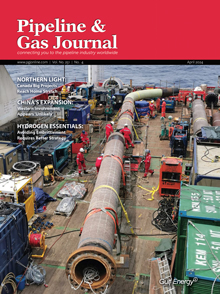April 2011 Vol. 238 No. 4
Features
Keep Eye On Unconventional Plays, Aggressive NOC Spending, IOC Restructuring

Wood Mackenzie’s annual review of global upstream M&A suggests that peak levels of deal activity in 2010, particularly at the end of the year, bode well for another big year in 2011. The independent researchers identify four key prevailing themes that underpinned total spend of US$183 billion in 2010 as: Unconventional oil and gas, weak U.S. gas prices, restructuring among the International Oil Companies (IOCs) and aggressive spending by the Asian National Oil Companies (NOCs).
Furthermore, emerging influences for 2011 such as interest in tight oil plays and the likelihood of restructuring in the Gulf of Mexico post-Macondo, will combine with the continuing factors from 2010 to drive deal activity for the year.
Luke Parker, lead analyst for Wood Mackenzie’s M&A Service explained: “The M&A market returned to peak levels in 2010 and the healthy deal activity at the end of the year bodes well for 2011. We have identified some key themes which contributed to the US$183 billion of deals of last year, many of which will continue to drive activity in 2011.”
Parker added: “The biggest driver of M&A activity in 2010 was unconventional resources and they are likely to remain so for the coming year. The market was underpinned by a steady stream of mid-sized deals; 20 in the US$1-5 billion range whereas 2009 was dominated by two ‘mega-deals’– Suncor/PetroCanada (US$19 billion) and ExxonMobil/XTO (US$41 billion).”
Wood Mackenzie’s Upstream M&A Service report ‘2010 in Review and the Outlook for 2011’ shows that U.S. shale gas in particular had an exceptional year in 2010 – continuing a steady increase in deal activity over the last five years – with acquisition spend amounting to US$39 billion, equivalent to 21% of all global M&A activity. Furthermore there was a year on year increase in Canadian oil sands-related spend, with notable acquisitions by Total, BP, Devon and the Asian NOCs.
Parker elaborated: “Weakness in the U.S. gas price saw investment increasingly shift toward liquids rich shale gas plays over the course of the year. Shifting strategies amongst smaller onshore U.S. players, struggling in the weak gas price environment, was another key driver.
“2010 ended with a flurry of shale oil transactions, centered on the Bakken play where we anticipate further activity in the coming year. In the last two months of 2010, there were four US$1 billion plus Bakken deals announced, pushing cumulative M&A spend in North American tight oil beyond US$15 billion.”
Total M&A spend had some distinctive trends by peer group as Parker explained: “At a global level, the NOCs were net buyers, and the IOCs were net sellers in 2010. The NOCs were almost exclusively acquisitive.”
The analysis notes that the Asian NOCs were very active in international deals in 2010, reporting that the Chinese NOCs, together with the Korean National Oil Company (KNOC) and PTTEP (the Thai NOC), invested US$35 billion in overseas acquisitions. This pushed total NOC cross-border spend as a proportion of global M&A to 19%, marking the sixth successive year in which the NOCs have increased their share of the market. 2010 was also the year that the NOCs outspent the Majors by US$16 billion, and for the first time made real headway in the U.S. and Canada. Sinopec and CNOOC were the biggest spenders, but KNOC significantly stepped up activity and PTTEP entered North America through a transformational deal in the Canadian oil sands.
“This peer group is focused on long-life resource capture – hence the attraction of LNG, deepwater, unconventional gas and heavy oil – so we can expect more non-operated stakes, aggressive buying overseas and potentially some big-ticket acquisitions in 2011,” continued Parker.
“2010 was a liquid market, which saw annual asset deal expenditure reach a new high at US$117 billion, underpinned by a round of portfolio restructuring across the sector,” said Parker. “BP, ConocoPhillips, Devon and Chesapeake were high profile sellers who between them sold US$45 billion of assets in 2010; US$5 billion more than the total market for assets in 2009. Many other companies took the opportunity to sell assets into a buoyant market.”
For the IOCs, 2010 represented a return to M&A across the board says Wood Mackenzie. Amongst the Majors peer group, Chevron, Shell and Total made a notable return to acquisition in 2010, while Statoil and ConocoPhillips were notable sellers. Amongst the Large Caps, Apache and Oxy – which Wood Mackenzie had previously noted as facing challenges in organic growth – were buyers. At the other end of the spectrum, Cairn, Devon, Chesapeake, Repsol YPF and Suncor between them accounted for US$29 billion of disposals.
“Despite high levels of liquidity, 2010 was not characterized as a buyers’ market. Competition for growth assets was intense, and supportive of value in the vast majority of deals,” added Parker.
Among the most uncertain potential themes for 2011 is the impact of the Macondo disaster on the M&A Market. “To date, Plains E&P is the only company to have announced major restructuring in the Gulf of Mexico post-Macondo. There was certainly no evidence of a reaction during the second half of 2010. On the contrary, record acquisition spending for the year underlined the strong allure of deepwater frontiers, Latin America and Africa in particular.
“We believe that much will depend on the regulatory and legislative fallout, which will take time to materialize. On balance, Wood Mackenzie anticipates that smaller players will scale down deepwater exposure, while bigger players will consolidate. For the time being, however, the vast majority of operators maintain a ‘wait and see’ approach,” concluded Parker.





Comments